
PREV ARTICLE
NEXT ARTICLE
FULL ISSUE
PREV FULL ISSUE
STACKS-BOWERS 2016 ANA RARITIES SALE SELECTIONS
Here are some items that caught my eye in the Stack's Bowers 2016 ANA Rarities sale. -Editor
Lot 3004: 1766 Pitt Farthing
 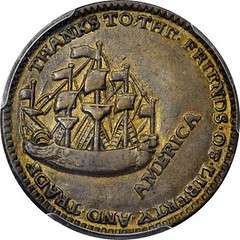
Finest Known 1766 Pitt Farthing
1766 Pitt Farthing Token. Betts-520, W-8345. Brass. AU-55 (PCGS). The French and Indian Wars of the 1750s took a huge toll on British finances, compelling Parliament to find new and creative ways to generate revenue to counteract the expenses incurred. One such proposal came to fruition in March 1765 with the passage of the Stamp Act, imposing tariffs on paper intended for use in the colonies and requiring the use of an embossed stamp. The colonists had no say in the law and vehemently opposed it from the beginning. The colonists found an ally in William Pitt, who worked diligently against the Act, finally succeeding in its repeal on March 11, 1766. The controversies surrounding the Stamp Act's passage and eventual revocation gave birth to the concept and expression of "no taxation without representation," a phrase that remains in common parlance, in particular on the current license plates for the District of Columbia. Precisely who authorized and struck the 1766 Pitt farthing and halfpenny tokens is not known. The traditional attribution for the pieces is based on the observations of by Montroville Dickeson in 1859 claiming that Philadelphia gunsmith and engraver James Smither produced them at the request of "The Friends of Liberty and Trade." Struck in two sizes, a farthing size, as here, and a halfpenny size, both bear the inscription THE RESTORER OF COMMERCE 1766 and NO STAMPS surrounding a bust of Pitt on the obverse, and on the reverse a ship at full sail, AMERICA in front of the ship's bow, all surrounded by THANKS TO THE FRIENDS OF LIBERTY AND TRADE. Given the nature of the inscriptions and the quality of workmanship, it is very possible that the pieces were struck in England at the behest of the merchant groups who supported Pitt. While usually called halfpennies and farthings, the weights fall far below Royal standard, were not proportional to each other and were likely not intended as such. Despite this, most known specimens are found heavily worn and likely saw some circulation at a time when coppers of any sort were in high demand. A few examples have been recovered by metal detectorists in America but it remains unknown if there were any large importations of the pieces. The farthing token is far and away rarer than its larger sibling and is missing in even the notable collections of colonial coins and related tokens. The offered piece is by far the finest known of the Betts-520 Pitt farthings and is tied with a "silvered" brass farthing; the next highest examples on the Condition Census are AU pieces noted with environmental damage. To read the complete lot description, see:
Lot 3169: 1851 Liberty Seated Silver Dollar Restrike
 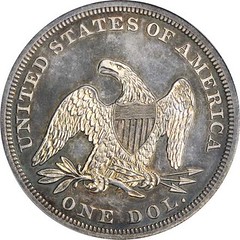
Unique "1851-O" Proof Liberty Seated Dollar 1851 Restrike on a New Orleans Mint Host Coin 1851 Liberty Seated Silver Dollar. Restrike--Overstruck on a New Orleans Mint Liberty Seated Silver Dollar--Proof-62 (PCGS). CAC.
The rarity of the circulation strike 1851 silver dollar (see below) and the absence of original Proofs from that year made this a prime candidate for restriking. These restrikes were quickly recognized as rarities once numismatics as a hobby began to flourish in the United States during the late 1850s. This is an unofficial restrike for, while it was produced under Snowden's authority alongside similar pieces, striking was conducted in secret and sales went through Mint officials and employees rather than through official government channels. Even so, today's collectors can be thankful for this extensive manufacturing activity, as otherwise many important rarities from the earliest decades of U.S. Mint operations would be unobtainable. Writing in the 1993 reference Silver Dollars & Trade Dollars of the United States: A Complete Encyclopedia, Q. David Bowers estimates that 50 to 100 restrike Proof 1851 silver dollars were produced beginning in 1859.
Intersting and unusual piece. -Editor
To read the complete lot description, see:
Lot 3292: The Byron Reed 1838 Eagle
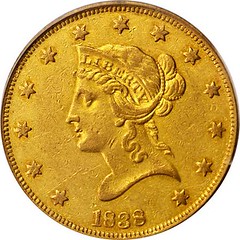 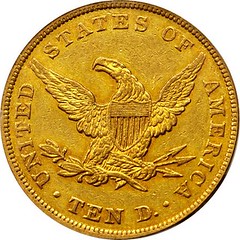
The Byron Reed 1838 Eagle 1838 Liberty Eagle. AU-50 (PCGS). In 1804 President Thomas Jefferson suspended both silver dollar and ten-dollar gold eagle production to prevent the loss to domestic commerce of newly minted coins through exportation and/or melting. By that time such practices had become so profitable that there was little point in the Mint continuing to produce new coins. When coinage of gold eagles finally resumed in 1838, not only was a new design introduced, but both the weight and diameter of the eagle were reduced. Whereas the Capped Bust Right eagle of 1795 to 1804 was produced to a weight standard of 17.50 grams with an approximate diameter of 33 millimeters, the coins struck beginning in 1838 weigh 16.718 grams and measure 27 millimeters in diameter. The design of the new eagle is attributed to Christian Gobrecht; its numismatic name, Liberty (Head), is derived from the left facing portrait that serves as the focal device on the obverse. As originally designed, Gobrecht's Liberty eagle features an obverse portrait with a broad, deeply curved truncation line and long strands of hair pulled across Liberty's ear from the temple to the bun at the back of the head. As well, the letters in the reverse legend UNITED STATES OF AMERICA are large in size. For reasons that have become lost to history, this design was deemed unacceptable for long-term coinage and was replaced in 1839 with one that features a slightly modified obverse portrait and smaller letters in the reverse legend. Examples of both types were produced in 1839. From Spink America's sale of the Byron Reed Collection, October 1996, lot 155; Heritage's FUN Signature Auction of January 2008, lot 3260. To read the complete lot description, see:
Lot 3525: 1868 Pattern Half Eagle. Judd-656
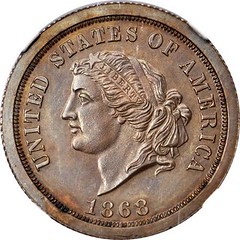 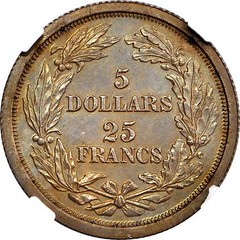
Intriguing 1868 Dual Denomination Pattern 1868 Pattern Half Eagle. Judd-656, Pollock-729. Rarity-7-. Copper. Reeded Edge. Proof-66 BN (NGC). Obv: A bust of Liberty faces left with the legend UNITED STATES OF AMERICA around the border and the date 1868 below. Liberty is wearing a ribbon inscribed LIBERTY and ornamented with a single star. Rev: The dual denomination 5 DOLLARS / 25 FRANCS within a wreath of laurel and oak leaves. This is a sharply impressed piece with razor sharp devices and broad, squared off borders. Olive-gold, pale blue and reddish-apricot undertones back up warmer copper-gray patina. Patterns of this type owe their existence to the international monetary convention held in Paris in June 1867. The purpose of that convention was to discuss the possibility of an international gold coin. Consensus was reached for the creation of a coin based on the French franc, Congressional leaders in the United States introducing a bill for a revised five-dollar coin whose weight would equal that of the proposed 25 francs piece. The pattern type represented here was produced to illustrate the proposed coin, which in the end was never authorized for regular issue production. The Mint struck examples of this dual denomination pattern in copper and aluminum, with a reeded and plain edge. Judd-656 in copper with a reeded edge is similar in overall rarity to the two aluminum variants with approximately a dozen specimens known. A lovely example to represent this little-known chapter in the United States Mint's extensive pattern and experimental coin series.
Someone could write a whole book on proposed coinages inspired by ideas floated at international monetary conventions. Several U.S.
patterns fit into this category, inclidingthe four-dollar "Stella". This unusual double-denomination piece is a great example.
-Editor
To read the complete lot description, see:
Lot 3531: 1915 Pattern Panama-Pacific Half Dollar
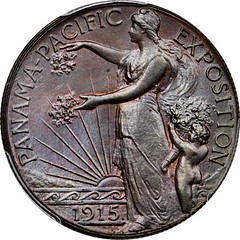 
Intriguing and Exceedingly Rare 1915 No S Panama-Pacific Half Dollar Only Four Known 1915 Pattern Panama-Pacific Exposition Commemorative Half Dollar. Judd-1792/1962, Pollock-2030. Rarity-8. Copper. Reeded Edge. Proof-67 RB (PCGS). Secure Holder. Struck from the regular dies of the Panama-Pacific Exposition commemorative half dollar, but without the S mintmark. The exact reason for producing the extremely rare off-metal strikings of the Panama-Pacific Exposition half dollar without mintmark have been debated by numismatic scholars over the years. Are they legitimate patterns, or are they fantasy pieces struck to create a numismatic rarity? Research by Roger W. Burdette published in the 2007 book Renaissance of American Coinage: 1909-1915 sheds considerable light on the backstory. With the authorizing legislation for the Panama-Pacific coins stating that they were to be struck at the San Francisco Mint, Philadelphia Mint Superintendent Adam Joyce believed that adding the S mintmark was unnecessary. Accordingly, the first half dollar dies were prepared without the mintmark. These were preceded on their way to the San Francisco Mint by the first Panama-Pacific gold dollar dies, which also lacked the mintmark. When these dies arrived in San Francisco on April 27, Mint Director Robert Woolley happened to be present and immediately objected to this omission. The ensuing correspondence between Woolley and Joyce (published in Burdette) explains what transpired and why,
What a gorgeous coin! I love the obverse design, and the strike and toning on this piece are amazing. Great story. Be sure to read the
correspondence exchange inthe lot description or Roger's book. -Editor
To read the complete lot description, see:
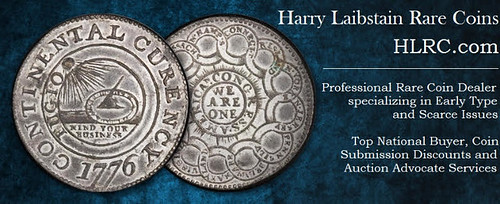
Wayne Homren, Editor The Numismatic Bibliomania Society is a non-profit organization promoting numismatic literature. See our web site at coinbooks.org. To submit items for publication in The E-Sylum, write to the Editor at this address: whomren@gmail.com To subscribe go to: https://my.binhost.com/lists/listinfo/esylum All Rights Reserved. NBS Home Page Contact the NBS webmaster 
|
